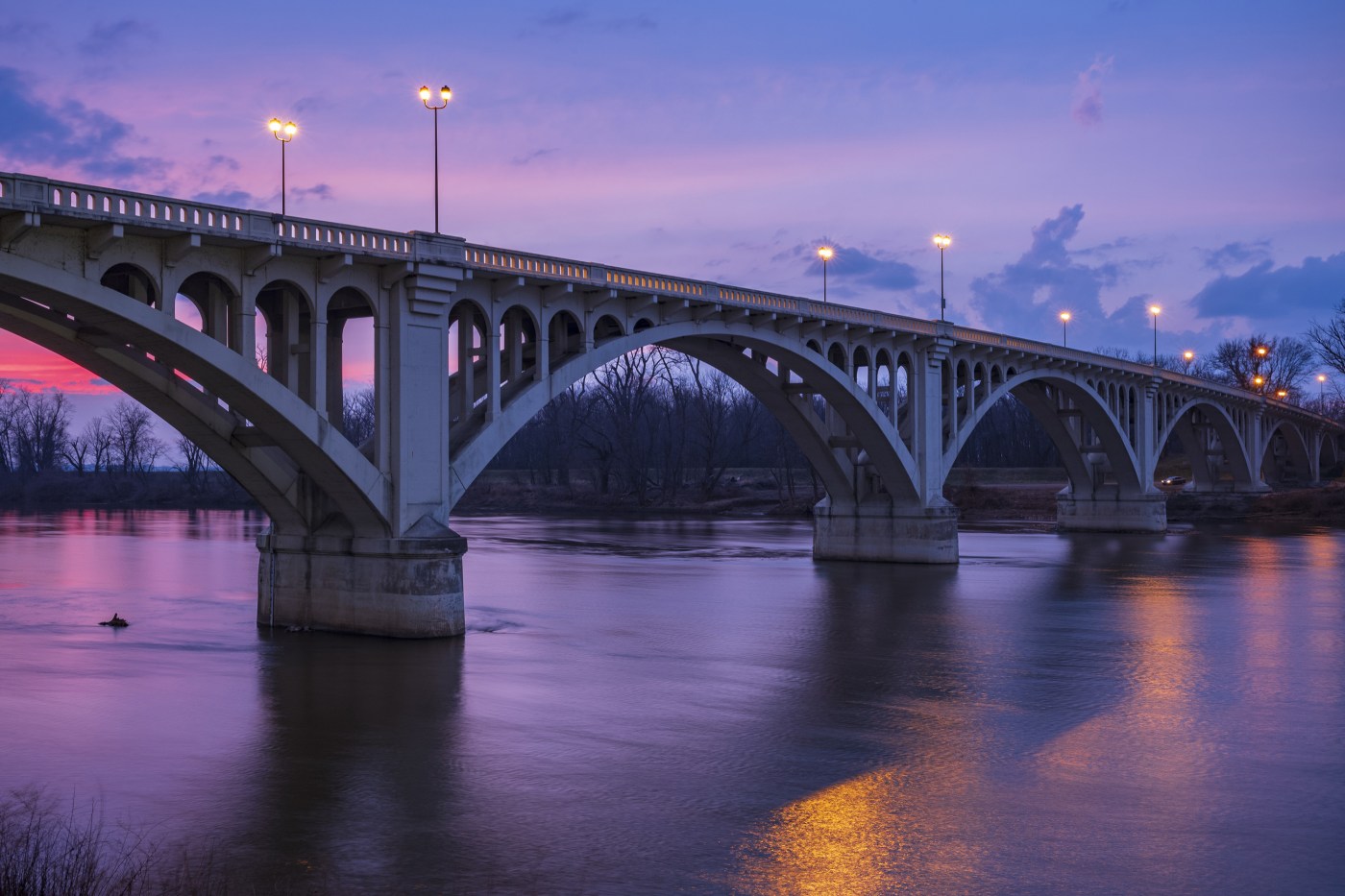For 200 miles, the Wabash River forms the border between Illinois and Indiana as it meanders south to the Ohio River.
On the Illinois side, lawmakers are scrambling to pass a bill that would protect wetlands from development and pollution, in order to safeguard water quality and limit flooding. But in Indiana, state policymakers hastily passed a law earlier this year to roll back wetlands regulations, at the urging of developers and farm groups who said such rules were overly burdensome.
That means the water that flows into the Wabash River from the west may soon be governed by very different standards than its watershed on the eastern side.
The divide is the result of a U.S. Supreme Court ruling last year that stripped federal protection from millions of acres of wetlands that had been covered under the Clean Water Act — leaving their fate up to the states.
“It creates a checkered landscape in terms of water quality,” said Marla Stelk, executive director of the National Association of Wetland Managers, a nonprofit group that represents state and tribal regulators. “Even if your state is doing all the right things, you could be downstream of a state that doesn’t have wetlands protections.”
In the first full legislative sessions since the ruling came down, lawmakers in some blue states, including Illinois, Colorado, New Mexico and Washington, have been drafting state protections or have increased state funding to replace the loss of federal oversight. Some red states, including Indiana, Missouri, North Carolina and Tennessee, have passed or considered measures to roll back safeguards that are no longer mandated by the feds.
The lobbying from environmental groups on one side and developers and farm groups on the other has sent states moving in opposite directions during the 2024 legislative session.
A ‘fallback plan’
The Supreme Court ruling in the Sackett v. Environmental Protection Agency case last year stripped Clean Water Act protections from wetlands that do not share a surface connection with a larger body of water, leaving out many waters that connect through underground channels. The decision leaves more than half of the nation’s 118 million acres of wetlands without federal oversight. In 24 states, no state-level regulations cover those waters, according to the Environmental Law Institute, a nonprofit research group.
“Illinois did not have a fallback plan,” said state Sen. Laura Ellman, a Democrat who is sponsoring the bill to protect wetlands under state law. “We’re cobbling one together right now. The intent is to restore what we had in place before.”
Democratic state Rep. Anna Moeller, the measure’s House sponsor, noted that Illinois has lost 90% of its wetlands since the early 1800s.
“Wetlands are important in improving water quality for drinking water because they filter contaminants,” she said. “They’re good for preventing flooding because they act as a natural sponge. They’re good for native species.”
Related Articles
Motorists creep along 1 lane after part of iconic Highway 1 collapses
Solar eclipse: How much will you be able to see in the Bay Area?
Are Bay Area homeowners getting any insurance breaks for beefing up their property to protect against wildfires?
California’s heat-stricken warehouse workers won’t soon be cooled due to holdup in new protections
Sierra Nevada snowpack ‘unusually normal’ and reservoirs are brimming as winter season winds down
Ellman and Moeller said bill supporters are working with state regulators to make some minor technical changes before it advances. Paul Botts, executive director of the Wetlands Initiative, a Chicago-based nonprofit, said environmental advocates and regulatory officials have concerns about funding for the program, which lawmakers hope will be largely covered by fees on permit applicants.
Backers don’t yet have a price tag for how much the permitting program would cost, and regulators in other states have found it difficult to cover their funding needs through fees alone.
But “the overall concept of Illinois stepping up where the feds have stepped back does seem to be resonating,” Botts said. “There’s plenty more sausage-making to come, because Illinois has not even had the bones of such a program. We’re really starting from scratch here.”
Unlike Illinois, neighboring Indiana did have state wetlands rules prior to the Sackett decision. But lawmakers moved quickly this year to shift some wetlands into classifications that have fewer protections.
“You have a ditch that’s backing up water and all of a sudden we’re calling this a wetland,” said Republican state Sen. Rick Niemeyer, the bill’s sponsor. “Our developers were having trouble with the definitions. Agriculture was getting hit with this.”
In Indiana, Illinois and many other states, local homebuilders’ groups have been among the leading voices to curtail wetlands regulation. Rick Wajda, CEO of the Indiana Builders Association, echoed Niemeyer’s assertion that the law will reduce protections only for “low-quality wetlands.”
“We look at any regulation to see if there’s ways we can bring more houses to the market,” he said. “If we allow a property to be used to its fullest intent, then maybe we can get more houses into the market and start to soften the housing shortage.”
But many environmental advocates in Indiana say the new law’s supporters are understating its effects. They argue that Republicans rushed the measure through the legislative process in just over a month to avoid public scrutiny.
“The more oxygen it got, the more Hoosiers would have spoken out against it,” said Democratic state Sen. Shelli Yoder. “If you look across Indiana and see the increases in flooding, the increases in drought, the presence of the worst kind of PFAS [chemicals], it’s hard to shrug off and say it’s just a mud puddle.”
Yoder said developers have told her that building on wetlands is an expensive task, even with no regulations in place, undermining claims that regulatory rollbacks will lead to affordable housing.
Writing new rules
Like Illinois, several other Democratic-led states have passed or considered bills to create wetlands protections or increase funding to state regulatory agencies to compensate for the loss of federal support.
In Colorado, state legislative leaders are expected to introduce a bill in the coming days that would establish state-level protections for the wetlands that lost coverage following the Sackett decision. Supporters say Colorado and other states with arid regions are especially vulnerable, because the Supreme Court ruling also cut protections for “ephemeral” streams that don’t flow year-round.
“We really only have one shot to get this right,” said Josh Kuhn, water campaign manager with Conservation Colorado, a Denver-based nonprofit. “Once these wetlands are destroyed, they’re basically gone forever. If we don’t have a strong program, we could see increased costs associated with water treatment, with the impacts of flooding, with the threat of wildfire.”
In New Mexico, state regulators already had been working to establish a permitting program that covers wetlands. State leaders say the court ruling increased the urgency to put state oversight in place.
“It got our legislature’s attention, hence the reason they were anxious to fund this,” said John Rhoderick, director of the Water Protection Division within the state Environment Department. “It’s easier to prevent contamination or degradation of your water than it is to have to clean it up after it happens.”
In the budget passed by state lawmakers earlier this year, Rhoderick’s agency received $7 million to help establish the program. The funding will allow the agency to hire enforcement staff, improve its mapping of state waters and establish a permitting database. Agency officials expect to publish draft rules this fall, with regulations officially in place by 2027. Once fully established, the program will require 35 to 50 dedicated staffers.
“The department has been short-staffed for a number of years,” said Doug Meiklejohn, water quality and land restoration advocate with Conservation Voters New Mexico. “This is critical. We’re pushing for development of a surface water permitting program, and that’s going to involve hiring people with expertise to put together regulations and standards where they’re needed.”
Lawmakers in Washington state also provided a funding boost for agency regulators. The state’s Department of Ecology already has well-established wetlands standards, but it’s expecting an influx of permit applications for waters that were once covered by federal agencies. With an extra $2 million, agency leaders say they’ll be able to add more staffers to ensure permits are processed on time.
“This will really help,” said Lauren Driscoll, manager of the wetlands program with the Washington State Department of Ecology. “We’re focused on getting things in place so we don’t have any delays.”
States step back
Indiana’s move to cut wetlands standards followed North Carolina’s rollback of state laws soon after the Sackett decision.
“We generally don’t regulate more stringently than the federal government,” Ray Starling, president of the NC Chamber Legal Institute, the legal strategy arm of the business advocacy group, told Stateline at the time.
While Republican lawmakers overrode the veto of Democratic Gov. Roy Cooper, the governor issued an executive order in February directing state agencies to conserve 1 million acres of natural lands, with an emphasis on wetlands. The order directed state leaders to avoid projects that would harm vulnerable wetlands, while also instructing state agencies to pursue more federal funding for wetlands restoration.
“It’s unfortunate that the state legislature tried to lock in the damage done by Sackett, but there are still things that can be done in places where a governor is more interested in environmental protection than polluter profits,” said Julian Gonzalez, senior legislative counsel for policy and legislation at Earthjustice, an environmental law group.
Meanwhile, a bill in Tennessee to eliminate state wetlands standards did not advance out of committee, following strong pushback from state regulators and environmental groups. Backers of the bill said environmental officials have made it too costly to farm or develops lands that have wet areas. The proposal was sent to a legislative summer study session.
The measure “has real consequences that would negatively impact Tennessee’s natural heritage and our environmental resiliency,” Grace Stranch, CEO of the Harpeth Conservancy, told the Tennessee Lookout.
Missouri lawmakers are considering a bill that would narrow state protections. In an analysis of the bill, the state’s Department of Natural Resources said the measure’s fiscal impact was incalculable, as the lowered standards could threaten the aquifers that provide drinking water to 59% of Missouri residents.
Agriculture groups have supported the bill, the Missouri Independent reported, saying current regulations apply to areas that would be better characterized as ditches.
Stateline is part of States Newsroom, a national nonprofit news organization focused on state policy.
©2024 States Newsroom. Visit at stateline.org. Distributed by Tribune Content Agency, LLC.












